The Nickel 1936 coin had a history of divisive designs before becoming one of the most widely produced and exquisitely designed coins of the 19th century. The renowned US sculptor, James Earle Fraser, is responsible for its magnificent design, with the famous Indian head on the coin’s obverse and the American Bison on its reverse. The coin received several improvements to make it better and more beautiful.
Learn more below about the 1936 Buffalo nickel’s features and unique variants that make the coin even more valuable to this day.
What Is the 1936 Buffalo Nickel Made Of?
The 1936 Buffalo nickel coin has a diameter of 21.20 millimeters, a weight of around 5.00 grams, and a metal composition of 75% Copper and 25% Nickel. This coin lacks the reeded edges of the coins you are accustomed to seeing.
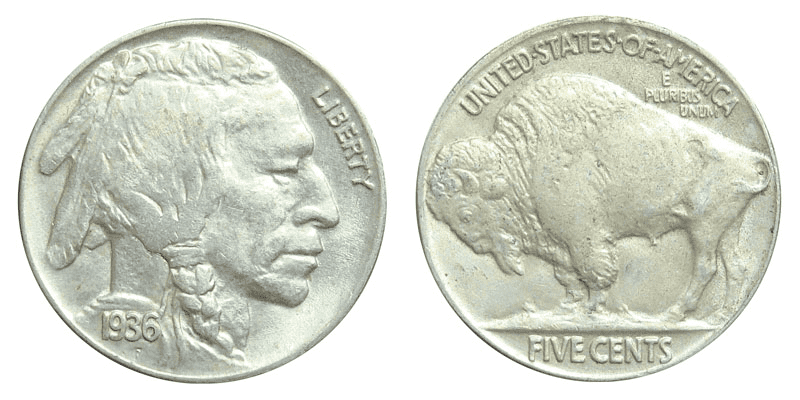
This stunning coin’s obverse features the bust of an American Indian facing right. His hair hangs below the man’s shoulder in a basic border. Two bird feathers on his head that dangle down to the back face the other way. The man’s right shoulder bears the year of minting, 1936, and the word LIBERTY is inscribed on the right corner of the coin. The designer’s initial F is placed under the year of minting.
The American buffalo, or bison, is placed in the center of the coin’s reverse. The words UNITED STATES OF AMERICA are inscribed arching on the bison. The coin also features a three-line Latin motto E PLURIBUS UNUM, which translates to “Out of many, one,” beneath the inscriptions, just above the bison’s back.
The coin’s denomination of FIVE CENTS is placed under the bison. You can find the coin’s mint mark under the coin’s denomination—D for the coins minted in Denver and S for those minted in San Francisco. The 1936 Buffalo nickels minted in Philadelphia do not bear any mint mark.
1936 Buffalo Nickel Varieties
Here is a summary of the Buffalo nickel varieties minted in 1936:
| Variety | Mint Location | Mintage |
| 1936 D Buffalo Nickel | Denver | 24,814,000 |
| 1936 S Buffalo Nickel | San Francisco | 14,930,000 |
| 1936 P Buffalo Nickel | Philadelphia | 118,997,000 |
| 1936 Proof Buffalo Nickel | Philadelphia | 4,420 |
| Total | 158,745,420 |
1936 D Buffalo Nickel
Edge: Plain
Mint Mark: D
Place of minting: Denver
Year of minting: 1936
Face Value: $0.05 (five cents)
Price: $1.13 to $13.00 (circulated condition); $558 to $9,096 (3 legs)
Quantity produced: 24,814,000
Designer: James Earle Fraser
Composition: 75% Copper, 25% Nickel
Mass: 5 grams
Diameter: 21.20 mm
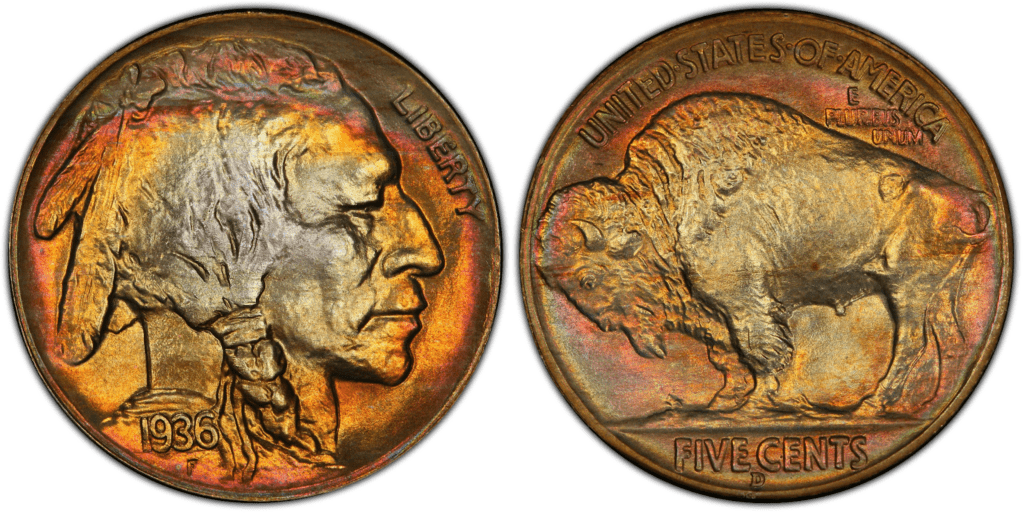
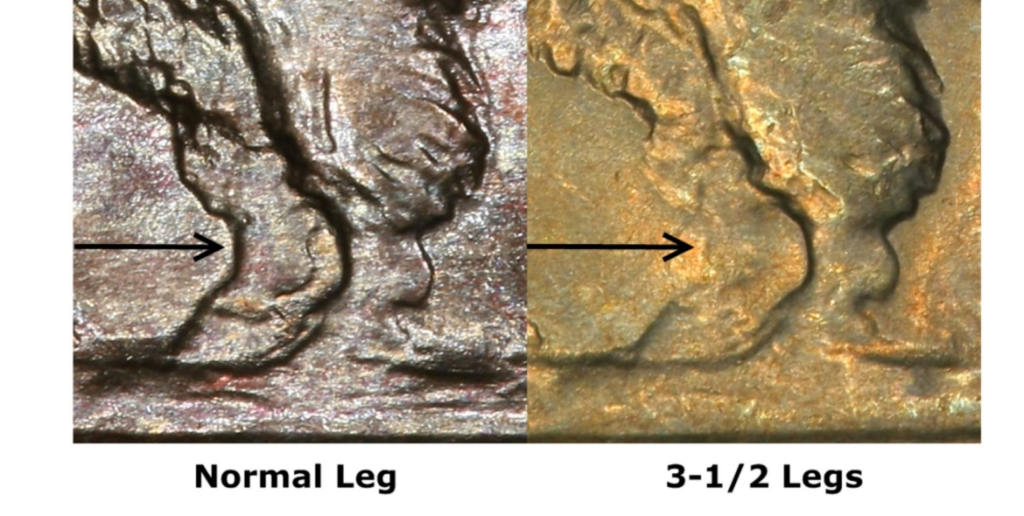
The Denver Mint took the lead in producing the best coins on average from 1936 through a large portion of the 1950s after producing coins of average quality for years. Thus, most 1936 D nickels were well-made, with outstanding shine and good to superior striking.
This issue is also extremely abundant with repunched mint mark variants, with at least 15 confirmed specimens with said error. NGC attributes the better of these under its VarietyPlus Service. Although a doubled-die reversal is equally common, collectors are almost entirely uninterested in it because of its subtlety.
The reverse die was overpolished, which produced the 1936 D 3 Legs Buffalo nickel variant. The variant is called so because the bison design’s front foreleg has less detail, making it look like the bison on the design only has three legs. The 1937 D 3 Legs Buffalo was made similarly but with a new die with harsher polishing.
There are less than 40 specimens of the 1936 D 3 Legs (Cherrypickers’ Guide). However, 134 samples had already been confirmed by PCGS as of April 2011.
1936 S Buffalo Nickel
Edge: Plain
Mint Mark: S
Place of minting: San Francisco
Year of minting: 1936
Face Value: $0.05 (five cents)
Price: $1.13 to $13.00 (circulated condition)
Quantity produced: 14,930,000
Designer: James Earle Fraser
Composition: 75% Copper, 25% Nickel
Mass: 5 grams
Diameter: 21.20 mm

Although the 1936 S is prevalent across all grades, it is the least frequent of 1936 to 1938 non-variety issues in mint state and Gem condition. For a Buffalo nickel produced at the San Francisco Mint for this year, the strike is normally sharp, and the luster is frequently of the grey brilliant variety.
The San Francisco Mint produced the greatest mintage Buffalo Nickel with this design, and examples are widespread in all grades up to MS 66. The fact that these coins were still being produced a few years later helped speculators in their endeavors because the populace avidly hoarded this issue at the time.
The majority of 1936 S Buffalo nickels were well-made. Although not all survivors can acquire them, they can be done so with great luster and sharp strikes.
1936 P Buffalo Nickel
Edge: Plain
Mint Mark: no mint mark
Place of minting: Philadelphia
Year of minting: 1936
Face Value: $0.05 (five cents)
Price: $1.13 to $10.00 (circulated condition)
Quantity produced: 118,997,000
Designer: James Earle Fraser
Composition: 75% Copper, 25% Nickel
Mass: 5 grams
Diameter: 21.20 mm
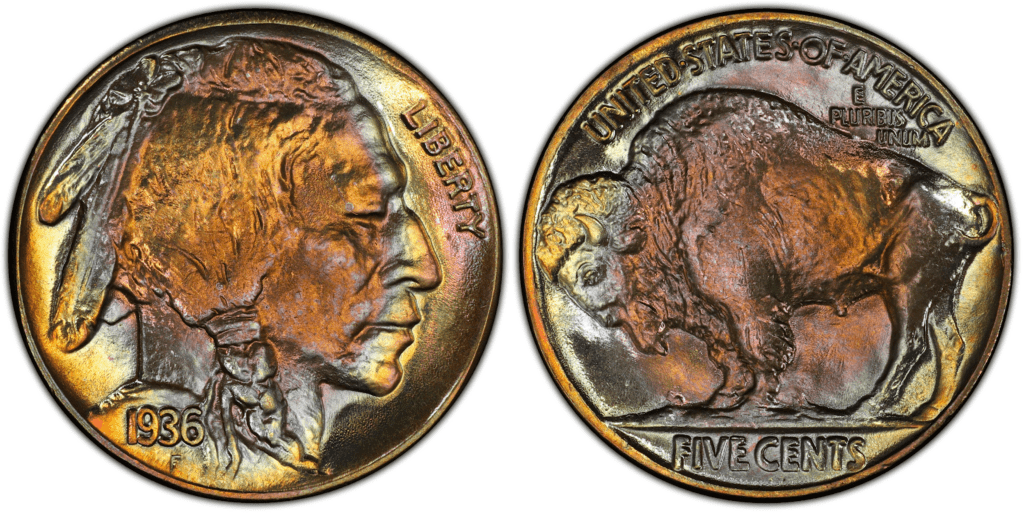
1936 was a year of hope because the economy was finally emerging from a protracted period of deep depression. Although this activity was untimely, it was enough to increase demand for new coins after years of little to no creation.
As a result, the 1936 Philadelphia Mint nickel had the largest mintage of any coin in this series. It makes sense that 1936 P nickels are widely available in Mint State. Most, however, are once more just partially struck; the middle obverse is a prime example of this.
One of the most prevalent Buffalo nickels across all grades is 1936. It is not as typical in mint state and Gem condition as 1937, 1937-D, 1937-S, and 1938-D, but it is nonetheless typical. Compared to 1936-D and 1936-S, it is slightly more readily accessible. The strike and luster are often strong and favorable.
Extreme die degradation is also frequent since dies were put to use much past their recommended lifespan. Even though all of these things work against the certification of gems, this issue is so prevalent that even MS 66 coins are frequently collected.
Numerous doubled-die variations are listed in the book by Wexler, Pope, and Flynn for both sides, but FS-101 is the one that has collectors excited. It is very noticeable on Mint State and little-used coins, but on more used coins, it could be more difficult to see.
The 1936 Buffalo nickel is valued at $1.71 in average condition and can be worth up to $45 in uncirculated (MS+) mint condition (USA Coin Book). Proof coins may be worth up to $1,268!
1936 Proof Buffalo Nickel
Edge: Plain
Mint Mark: no mint mark
Place of minting: Philadelphia
Year of minting: 1936
Face Value: $0.05 (five cents)
Price: $0.22 to $3.30 (circulated condition)
Quantity produced: 4,420
Designer: James Earle Fraser
Composition: 75% Copper, 25% Nickel
Mass: 5 grams
Diameter: 21.20 mm
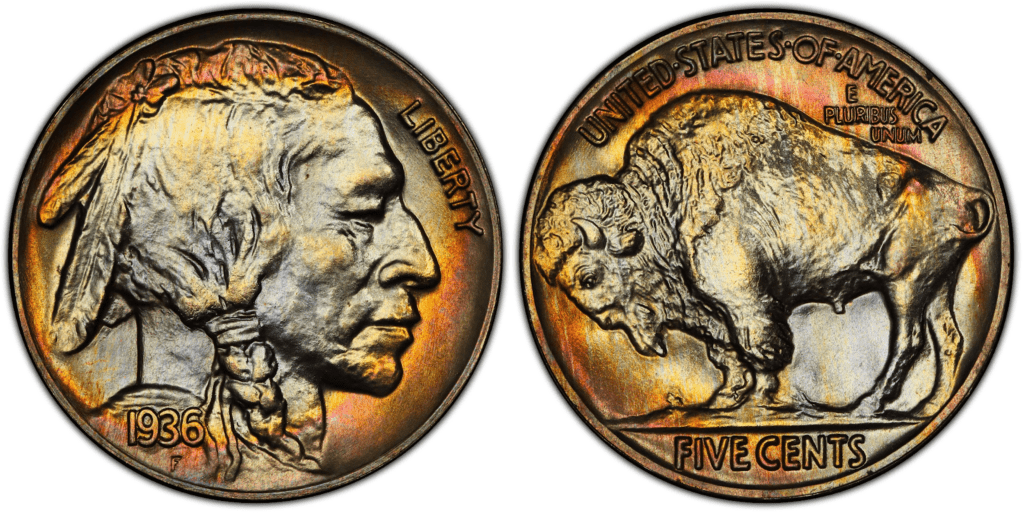
Two alternative finishes of the 1936 Proof Buffalo nickels were produced by the Philadelphia Mint: the Satin finish and the Brilliant finish.
The first variant made from the two was the 1936 Satin Finish Proof Nickel. Given that the Satin Finish coins resembled circulation strike coins, it is thought that the Mint may have switched them to a Brilliant Finish.
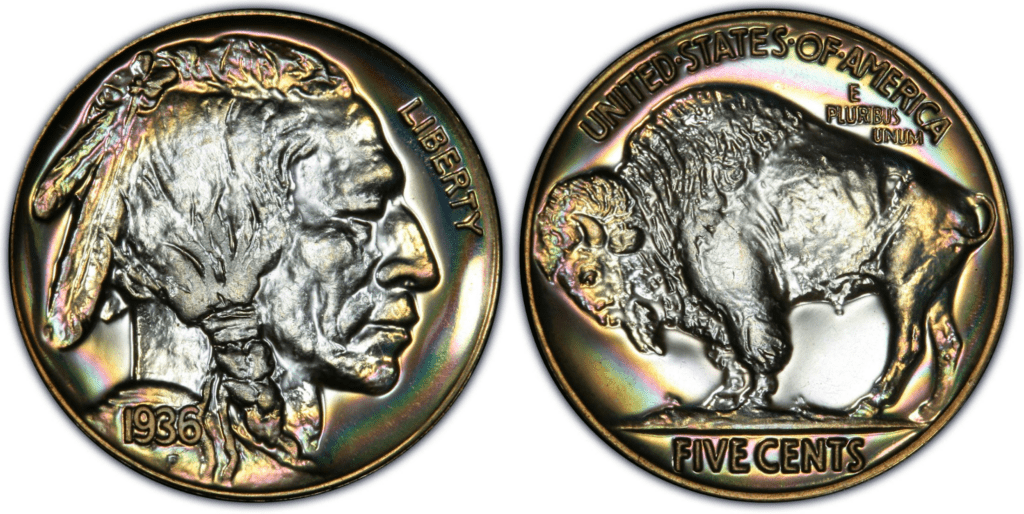
The Satin Finish and the Brilliant Finish appear equally durable across all grades. The 1936 Satin Finish Proof Nickel is substantially more prevalent than the 1936 Brilliant Finish in high grades of PR67 or higher.
List Of 1936 Buffalo Nickel Errors
Struck Through Error
A “struck-through” error occurs when a foreign object is struck into a coin, leaving an impression. Such inaccuracies are always more compelling when the object’s nature and place of origin are seen.
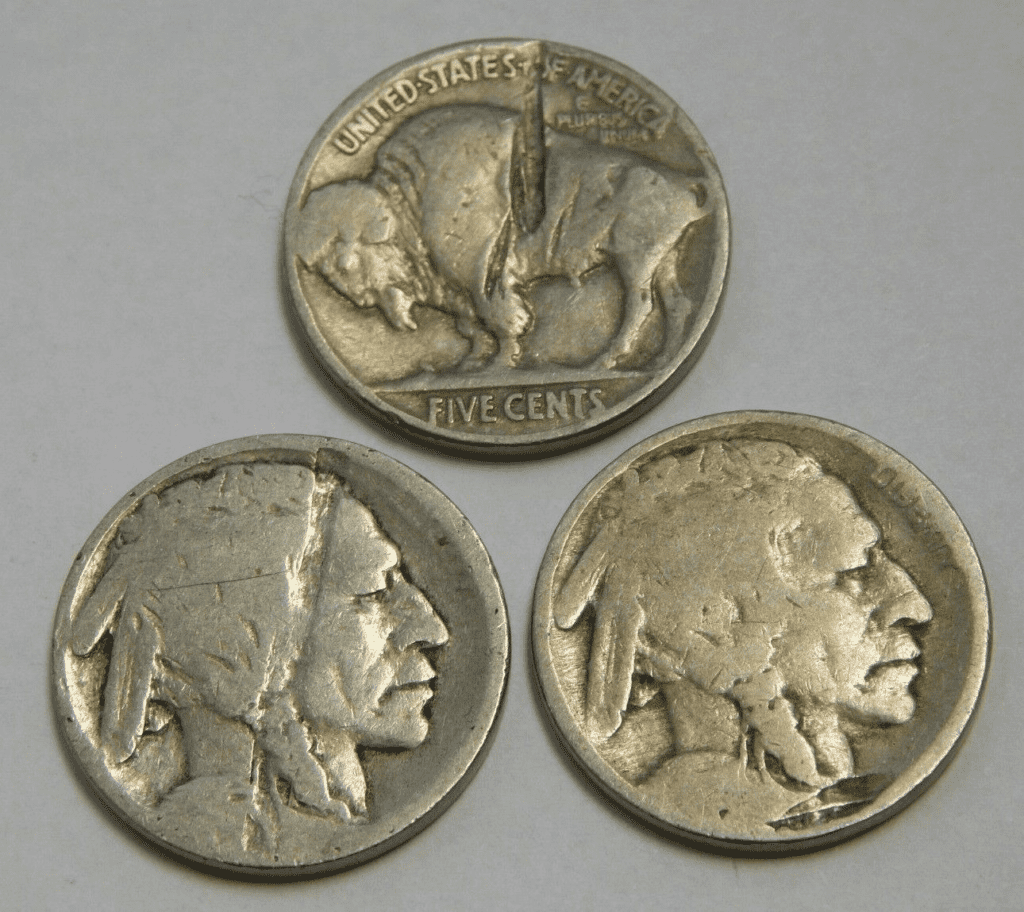
Lamination Error
Planchet defects called lamination errors cause coins’ surfaces to flake and break. It is commonly accepted that the alloy’s impurities that cause the metal to split along the horizontal plane are to blame for lamination mistakes. Errors in the lamination can appear either before or after the strike.
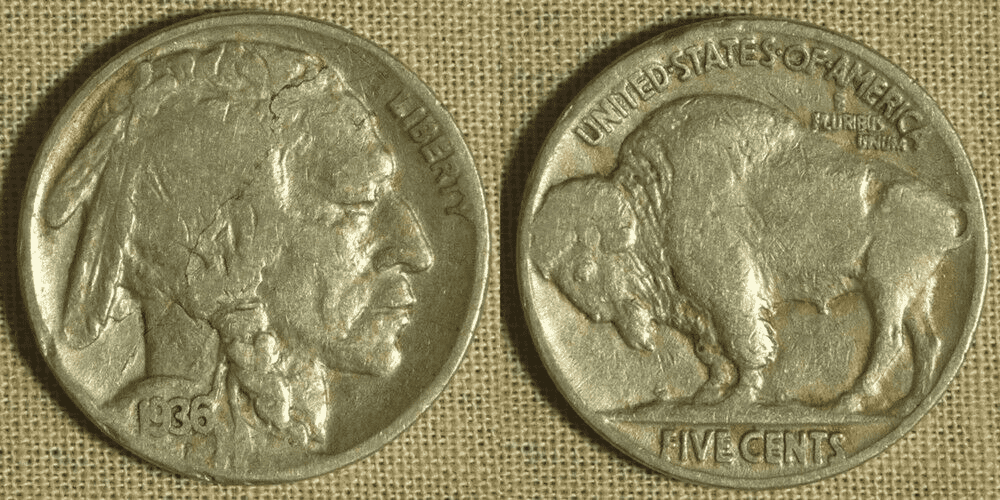
Repunched Mint Mark Error
A repunched mintmark variant is produced when the letter punch used to add the mint mark into the working die leaves two or more offset imprints. Nearly invariably, the impressions cross over. It is very rare to see a secondary mintmark that is entirely distinct.
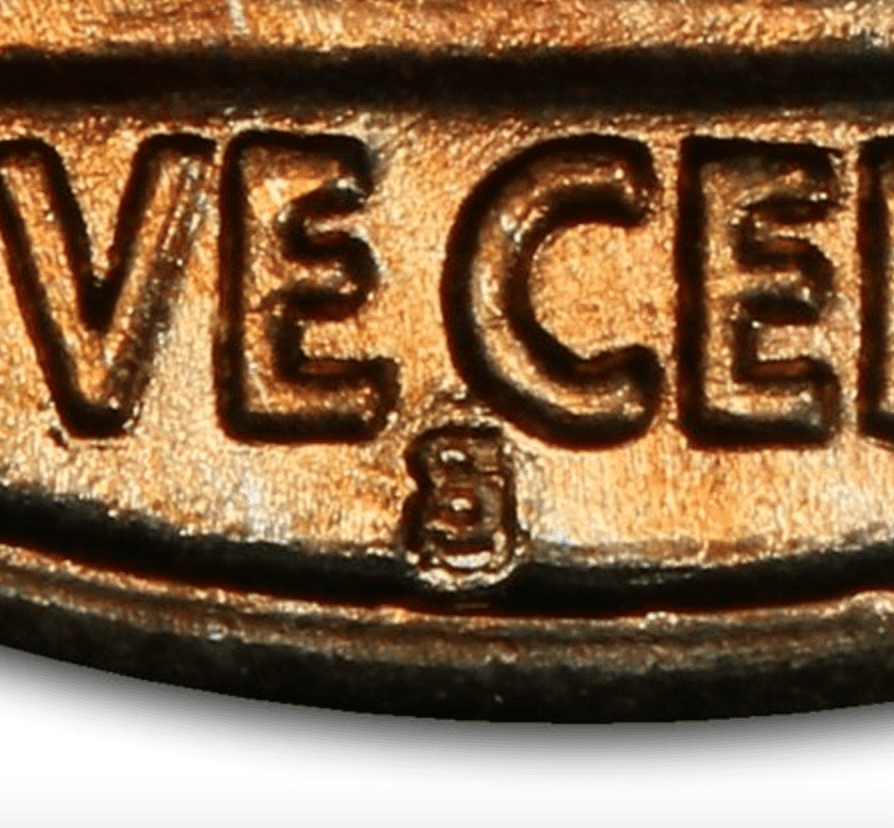
Doubled Die Error
A type of coin die variant is a doubled die. In most cases, it happens when a hubbing defect duplicates the design on the die. The design on the die will appear again, or possibly three or four times, when the hub strikes it at a slightly different angle.
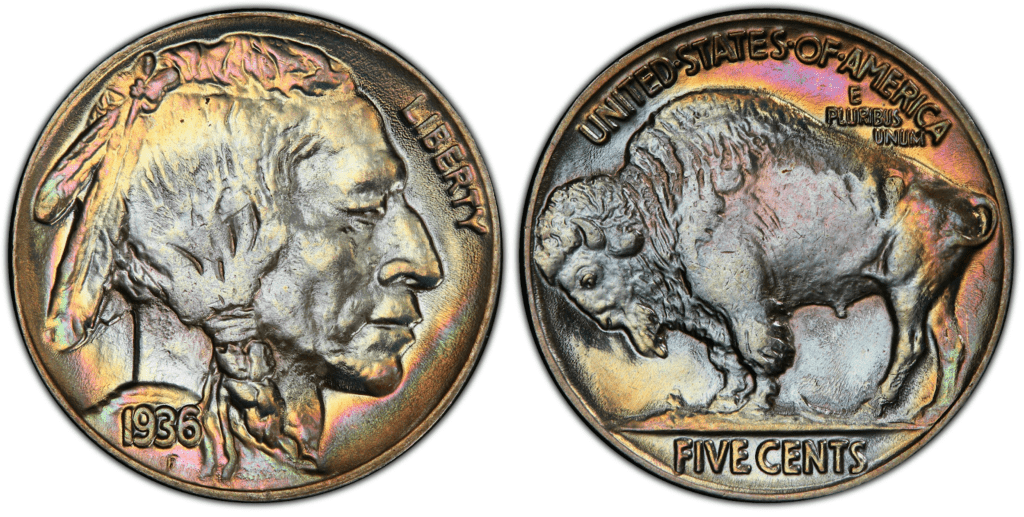
How Much Is The 1936 Buffalo Nickel Worth Today?
According to the NGC Price Guide (January 2023), the 1936 D Buffalo nickel is valued between $0.50 and $32.50 in circulated condition. The ones minted in San Francisco, in circulated condition, cost between $0.50 and $35. Meanwhile, the Philadelphia variants are worth between $0.50 and $20.
However, buy or sell these coins in pristine, uncirculated condition on the open market. You can make up to $30,000 for the Denver variant, $3250 for the San Francisco variant, and $37500 for the Philadelphia variant.
How Does The Grading System Work?
To find out the value of your coin, get in touch with businesses that provide expert coin grading services, including the Numismatic Guaranty Corporation (NGC) or the Professional Coin Grading Service (PGCS). By properly evaluating your coins by these experts, you can see a significant increase in their value.
These coin assessors use tools like magnifying glasses and microscopes to see even the finest details of a coin. They will assess the coin’s brilliance, strike, color, preservation, and attractiveness to ascertain its condition and value.

In addition to these tools, the Sheldon Scale, a 70-point grading system that precisely identifies a coin’s grade, is also used by the PCGS and the NGC. Using the Sheldon Scale, coin assessors can determine whether your coin is MS (Mint State) or PR (Proof).
Where To Buy Or Sell 1936 Buffalo Nickel?
The most practical way to acquire or sell a 1936 Buffalo nickel is through online markets like auction sites. Many sellers place bids on rare coins on websites like eBay, Etsy, Amazon, and Craigslist. Aside from these online marketplaces, coin and antique stores are other places to buy or sell your 1936 Buffalo nickels. However, you should note that finding one there might be harder.
If you need suggestions on where and how to buy or sell your 1936 Buffalo nickels, you can also consider asking reliable coin grading service providers like the PCGS and the NGC for help.
FAQs
What makes a 1936 buffalo nickel rare?
The more errors the coin has, the more valuable it will be. So, look for coins with errors such as a struck-through error, a lamination error, a repunched mint mark error, or a doubled die error. Moreover, 1936 buffalo nickels with grades from MS67 and PR67 are considered rare since only a few exist today.
How do I know if my 1936 Buffalo Nickel is valuable?
Examine the regions of the coin that are frequently worn away. Your coin might be valued with clearly visible minting dates, mint markings, denomination, bison tail, and bison horns.
What is the error on a 1936 buffalo nickel?
The 1936 Buffalo nickel 3 Legs error is only seen on Denver Mint coins. If you check the coin’s reverse, you can see this particular error on the Buffalo’s front legs. Due to a minting error, the right leg is hardly visible. As a result, the buffalo in the design seems only to have three legs.
